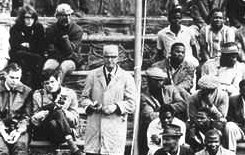Shortly after birth,
most Americans have the ethnic/racial group
identity of their biological parents placed on their birth certificates. This provides an
identity for children that will usually stay with them throughout their lives and will
have a major impact on how they see themselves and how others treat them. It often
restricts their choices of friends and marriage partners. It may give them
advantages or it may create road blocks in their educations, careers, and the neighborhoods
in which they wish to live.
Many, if not most, European Americans now believe that this official ethnic/racial classification and life-long tracking is unnecessary. The writer Tony Morrison has observed that "whites see themselves as unraced." For those who do not label themselves in terms of "race", official racial designations naturally seem irrelevant and even counter productive to social harmony and individual rights. In contrast, members of ethnic/racial minorities generally see value in this group classification system because they do not consider themselves to be "unraced." For them, labeling may prevent their official invisibility and subsequent social and economic discrimination. This view is not surprising considering the history of past discrimination and even slavery of some groups.
The official state and national government practice over the last century in the U.S. was to try to force everyone into one of a number of specific racial/ethnic categories for the national census, hiring goals, college admission records, etc. Ultimately, these categories are based on the false assumption that somewhere there are "pure races" and "pure cultures." Such groups do not exist today and may never have existed due to intergroup mating and to the more or less constant diffusion of culture traits around the world. Despite the fuzzy assumptions about the nature of ethnicity and race, groups based on these phenomena continue to be officially recognized largely because it is politically popular.
In many cases, being assigned to a particular ethnic/racial group on birth certificates and national census reports in America is somewhat arbitrary and mostly based on how people wish to define themselves and their children. In part, this is due to the fact that the high frequency of intermarriages has resulted in millions of Americans who no longer have a simple, straight forward group identity--they could be legitimately placed into a number of ethnic/racial group categories.
Which ethnic/racial category is selected for birth certificates
and national census reporting has tended to vary with the social situation and historical
changes. The Chumash
![]() Indians of the Santa Barbara area of California provide an
example of this phenomenon. Up until the 1960's, it was thought that there were no
surviving Chumash. The last one had presumably died in the 1940's. In fact,
for a generation, they had been defining themselves as Mexican for census
purposes. Only with the political reawakening of Native Americans in the 1960's did
they once again claim to be Chumash. Now even people with very remote Chumash
genetic ancestry and virtually no Chumash cultural heritage are claiming to be Chumash.
Indians of the Santa Barbara area of California provide an
example of this phenomenon. Up until the 1960's, it was thought that there were no
surviving Chumash. The last one had presumably died in the 1940's. In fact,
for a generation, they had been defining themselves as Mexican for census
purposes. Only with the political reawakening of Native Americans in the 1960's did
they once again claim to be Chumash. Now even people with very remote Chumash
genetic ancestry and virtually no Chumash cultural heritage are claiming to be Chumash.
In the 1990 U.S. census, everyone who was not defined as being Native American, Asian, or Pacific Islander apparently was assumed to be "black" or "white." This simplistic system was used despite the fact that for four centuries, there has been considerable intergroup mating and extensive cultural exchanges between European, African, and Native Americans. Asians and Pacific Islanders have also been added to the mix over the last 1 centuries, especially in Hawaii and urban areas of the western states.
 |
|
"Multi-racial" Americans |
|
Many Americans of mixed ancestry do not fully identify with the single racial/ethnic category that they have been assigned to and do not feel comfortable with it. For instance, when one parent is of European and Chinese descent and the other is African and Native American, what single category would their children fit into? For many Americans with complex ancestries such as this, the answer is that they are multi-racial, mixed-racial, or multi-ethnic. The number of these multi-racial children in America has doubled during each of the last 3 decades.
When asked to provide personal family information for the year 2000 Census, nearly 7 million Americans reported that their ancestry included two or more "races." The real number of multi-racial Americans is certainly far higher. Government agencies have been officially blind in the past to such realities except for providing the option of the ambiguous category of "other race" on information request forms. There are several active national lobbying groups trying to get a "multi-racial" category added to future censuses and other federal records. Strongly opposing this addition are racial/ethnic rights organizations, such as the National Association for the Advancement of Colored People and the National Council of La Raza. Apparently, their opposition is due to anticipated decreased numbers in their groups and a subsequent loss of political power. While the year 2000 census for the first time allowed people to identify themselves as being members of more than one "race", a "multi-racial" category was not allowed. Compounding the problem of getting an accurate picture of American society, the U.S. Census Bureau decided that people who identified themselves as black and some other "racial" group on the year 2000 census would be counted as being black for some purposes--they would not be given a choice. This created the curious situation in which someone who is 90% Asian and only 10% black would not be considered Asian.
There has been an inconsistency in the official definition of ethnic/racial group categories in America. Depending on the company, institution, or government entity, the number of categories used over the last two decades has ranged from 5 to 20 or more. The trend has been progressively to break down all categories, except "black" and "white", into smaller, more specific groupings. For example, the Pacific Islander group category is now commonly divided into Filipino, Guamanian, Hawaiian, Samoan, and "Other Pacific Islander."
|
|
 |
|
"Other Pacific Islander" |
East Indian |
In addition, some people have been officially shifted from one category to another in the census. For instance, people from India were commonly defined as "white" in the past. Now, they are usually considered to be Asian or given their own group category--Indian or East Indian. Despite objections based on feelings of national identity, people from Pakistan, Bangladesh, Nepal, and Sri Lanka also are usually labeled as being Indian.
Ethnic Identity in Other Societies
Outside
of the United States, the
racial/ethnic pie has been divided up differently. During the apartheid
![]() era of South
Africa (largely from the 1960's through the early 1990's), there were
four officially
enforced categories of "races"-- European (100% European), Asian
(100% East Indian), African (100% African), and Colored (mixture of
European and African). At times, siblings of mixed ancestry were placed into
different "racial" groups based solely on skin color. As a result, some
brothers and sisters were legally prohibited from socializing together. As a further
indication of the arbitrariness of the South African system, business travelers from Japan
were considered to be European. This allowed Japanese
visitors to interact socially with the European minority that controlled the
government and economy in South Africa.
era of South
Africa (largely from the 1960's through the early 1990's), there were
four officially
enforced categories of "races"-- European (100% European), Asian
(100% East Indian), African (100% African), and Colored (mixture of
European and African). At times, siblings of mixed ancestry were placed into
different "racial" groups based solely on skin color. As a result, some
brothers and sisters were legally prohibited from socializing together. As a further
indication of the arbitrariness of the South African system, business travelers from Japan
were considered to be European. This allowed Japanese
visitors to interact socially with the European minority that controlled the
government and economy in South Africa.
|
|
|
Rigidly segregated stands at a
South African |
In 17th century Spanish colonial America, there were 15 "racial" categories based on the percent of one's ancestry from different groups:
| Bermejos | 100% European |
| Indios | 100% Native American |
| Negros | 100% African |
| Mulatos | European and African mixture (7 categories) |
| Mestizos | European and Native American mixture (5 categories) |
The term "mestizo" is still commonly used in Mexico. Depending on the person speaking, it can be a term of pride or of derision. "Ladino" is now more often used instead of "mestizo" in Central America. Cultural traits are often as important as biological ones in ethnic identity there. In Guatemala, for instance, it is often language (Spanish or Maya Indian), education, and style of clothing that are used to identify people as being ladino instead of indio (Indian).
In 18th century French colonial Haiti, there were 9 categories of African and European mixture that were defined based on the assumption that people have 128 parts of inheritance:
| Blanc | 100% European (128 parts European ancestry) |
| Ngre | 100% African (128 parts African ancestry) |
| Multre | 64 parts European and 64 parts African |
| Sacatra | 8 to 32 parts European |
| Griffe | 24 to 39 parts European |
| Marabou | 40 to 48 parts European |
| Quateron | 71 to 100 parts European |
| Mtif | 101 to 112 parts European |
| Mamelouc | 113 to 120 parts European |
| Quateronn | 121 to 124 parts European |
| Sang-ml | 125 to 127 parts European |
These "racial" terms are still important to many people in Haiti, especially members of the largely mixed ancestry upper class. Similar kinds of distinctions are found in the neighboring Dominican Republic today.
Summary
Most people around the world are identified in terms of ethnic and/or "racial" identity at birth. However, ethnicity is not a static phenomenon. Ethnic groups can change through time in complex ways. Similarly, individual identity in heterogeneous societies today, such as the United States, Canada, and Brazil, can also be flexible--individuals may identify themselves as being members of different ethnic groups or "races" at different times. Unfortunately, governments usually are the last to recognize and respond to the changes. Ethnic/racial group organizations often play a major role in the definition of group identities and in the maintenance of boundaries between groups--they usually act as conservative forces by resisting assimilation into the majority population.

